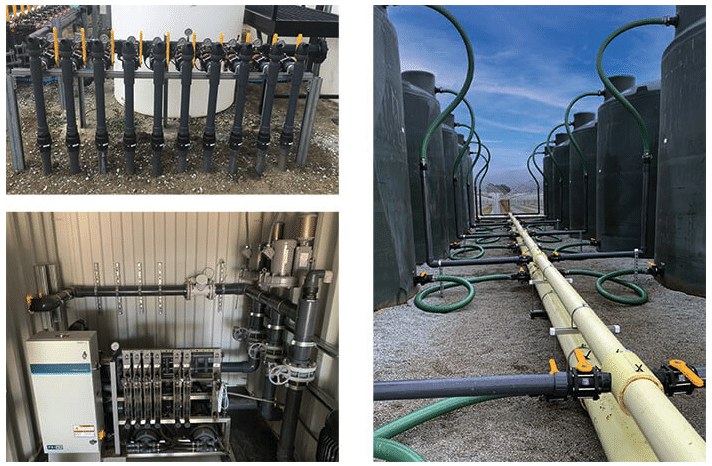(This article originally appeared in Irrigation Today)
Substrate growing is a term you hear a lot these days, but what does growing in substrate actually mean? Your science book would describe substrate as the surface or material from which an organism lives, grows or obtains nourishment.
For large production agriculture, we typically think of the soil as the substrate. While this isn’t technically incorrect, substrate growing is actually referencing the growing of plants in an alternate media usually made up of a mixture of coco coir and peat moss, rockwool, etc. This is becoming an emerging practice for several crops including raspberries, blueberries, blackberries, strawberries, lettuce, tomatoes, cannabis and more.
There are several reasons why this type of growing practice is gaining interest, such as increasing labor costs, lack of labor availability, stricter regulations, land availability, etc. This is nothing new for other countries; however, it is a new adoption in the United States and is likely to continue to increase rapidly.
Substrate in production
What does this look like in production? For most people, the first thing that comes to mind is greenhouses. Large greenhouses growing in a substrate media are not particularly new in our industry. These could include hot house tomatoes grown vertically in a rockwool substrate or a cannabis facility filled at a high density with 4-liter pots.
The future of substrate growing is hitting the fresh berry market hot and heavy. Imagine driving past 100-acre fields covered with the familiar plastic hoop houses, but inside are tidy little lines of 7-, 10- and 30-liter pots growing all your favorite caneberries. Or, these covered fields could house giant, juicy strawberries hanging perfectly from 3 feet in the air. Called “tabletop strawberries,” these strawberries are grown on narrow tables at a high density inside a hoop house. This is a stark difference from the traditional strawberry production consisting of a variety of bed sizes wrapped in black plastic mulch with hardworking pickers bent over for hours harvesting and hand packing strawberries into the clamshells consumers buy at the store.

Berries grown in substrate are elevated off the soil where they have less chance of bruising or mold growth from laying against the mulch plastic. The pickers are now able to stand up to harvest and pack berries, which leads to increased harvest productivity. Since nothing is being grown in the soil there is no need for fumigating between growing cycles, no ground prep to create beds, no plastic mulch to pull/recycle/reinstall, and no drip tape to recycle and purchase again.
Although this type of production offers numerous positives, there is a substantial investment in infrastructure needed. The tables for growing are specialized equipment and must be supported by a steel post approximately every 10 feet, and each hoop house contains four to six tables. The sheer volume of materials that go into these ranches is substantial, not to mention the substrate materials itself, which come in several forms such as in long plastic bags, a long pot or open troughs with loose substrate. For the most part, California berries are grown in the open field, not under a hoop house.
Irrigating in substrate
When considering growing in substrate, a question that arises is: Can we just use the same irrigation system we have? In most cases, the answer is no. Traditional growing in soil involves irrigating a large area with a large volume of water typically a few times a week. The soil itself has a large water holding capacity so that plants are able to use water as needed over a long period of time. When growing in substrate, the plant is growing in a very small container. Although the substrate may have a good water holding capacity, there is only a very small amount of it. Irrigation in substrate typically involves irrigating 10 to 20 (or even more) times per day. Substrate irrigation provides the plant with the exact amount of water and nutrients that it needs right when it needs it. This is called pulse irrigation.

In a traditional field, if the well on the property breaks, there is probably a day or two to get it repaired before experiencing any issues with the plants since the soil has large water holding capacity. In a substrate ranch, the plant only has enough water in the substrate for maybe an hour. This poses a significant challenge related to water availability, as well as a requirement for redundant equipment in the irrigation system. Typically, the solution is to either install a reservoir or a large “tank farm” with holding capacity for the whole ranch for at least one day. In some cases, several redundancies are built to act as a safeguard in case of pump or equipment failure.

Automation is also something that is now not just a luxury — but a requirement. The need for constant injection of fertilizer and pH correction during each irrigation is very important as well as something to control the pulse irrigation schedule. Without automation, someone would have to attempt to open and close all the irrigation valves across the ranch in a matter of minutes every hour. Instead, investment must be made in fertilizer injection hardware, electric valves, pumps, etc. and a software platform that will allow for fertigation control and irrigation scheduling. These platforms are tied into weather data and in-field sensors that allow for better decision-making for the irrigation schedule. These sensors can also be used to completely automate the irrigations themselves or adjust scheduled irrigations based on real-time feedback from the field.
The future of agriculture is always evolving, and with external forces now pushing our traditional way of growing in a new direction, there is an exciting future ahead for blending agriculture and technology. As we work together with growers to develop best practices, and as our industry partners to bring new products and software into the agricultural space, it is an exciting time to watch this new trend evolve.





